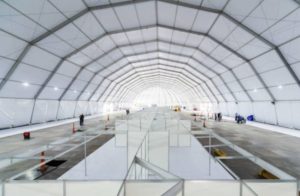
COVID-19 and temporary healthcare facilities around the world
 During this COVID-19 outbreak, many building regulators around the world are facing a challenge between the need of healthcare facilities to quickly expand their capacities to treat infected and highly contagious patients and the need to ensure building safety. Because of the urgency to erect what will ultimately be temporary healthcare buildings, the normal regulatory compliance routes are often not practical. Each jurisdiction in the U.S. is creating its own pathway, often relying on guidance from the Centers for Medicare and Medicaid Services (CMS), the U.S. Army Corps of Engineers, and the Federal Emergency Management Agency, but how are other countries addressing the challenge?
During this COVID-19 outbreak, many building regulators around the world are facing a challenge between the need of healthcare facilities to quickly expand their capacities to treat infected and highly contagious patients and the need to ensure building safety. Because of the urgency to erect what will ultimately be temporary healthcare buildings, the normal regulatory compliance routes are often not practical. Each jurisdiction in the U.S. is creating its own pathway, often relying on guidance from the Centers for Medicare and Medicaid Services (CMS), the U.S. Army Corps of Engineers, and the Federal Emergency Management Agency, but how are other countries addressing the challenge?
This question was posed among members of the Inter-Jurisdictional Regulatory Collaboration Committee (IRCC) and here are some of the takeaways.
Australia
The Standard on Temporary Structures developed by the Australian Building Codes Board would apply, but each individual state or territory is responsible for implementation and enforcement of this standard, as well as in relaxing any applicable rules that would govern the use of temporary or repurposed structures for healthcare during the crisis.
Germany
Emergency hospitals used for COVID-19 are considered works for civil protection and simply require notification to the local building authority – no permitting is required – however, building owners, designers and contractors are expected to ensure material fire safety and stability requirements are being met.
Japan
Under the Prime Minister’s declaration of emergency on April 7, 2020, the construction of temporary medical facilities by prefectural governments is exempt from all provisions of the Building Standards Law, and prior to that temporary medical facilities were already being constructed to treat COVID-19 patients under the emergency temporary buildings exemption under the Building Standard Law of Japan, which eliminates the requirements for plan review and inspections.
Netherlands
A process exists under the Dutch Building Decree for permitting temporary buildings, and municipalities may expedite their administrative processing to allow for approval in principle in as quickly as one day.
Norway
Adopted a temporary regulation allowing municipalities to exempt health authorities from applying for a permit for the temporary use change of buildings and erection of temporary buildings to be used for healthcare services.
Scotland
Guidance has been issued to the authorities that enforce the building regulations to not enforce building codes against health boards constructing temporary healthcare buildings.
Singapore
The Temporary Building regime should be followed to obtain a Temporary Building permit from the Building and Construction Authority, which involves plan review (up to one week processing time) and occupancy permitting; further approvals are required for fire safety, national parks, pollution control and vehicular parking but those can be sought after the occupancy permit has been issued and the temporary building is in use.








